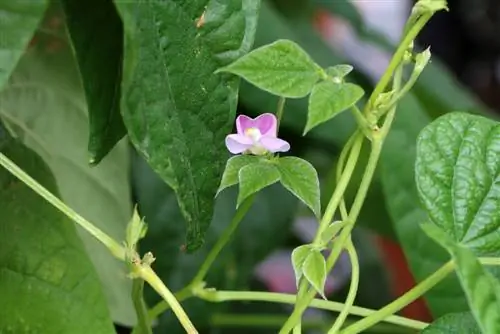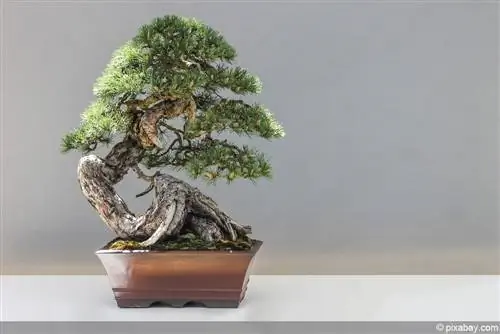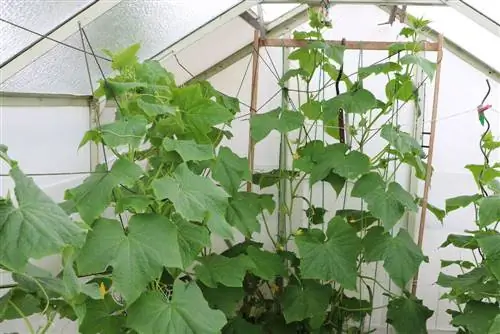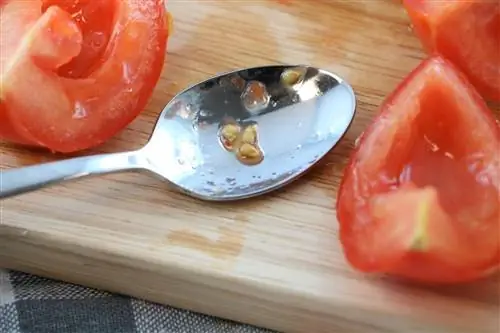- Author admin [email protected].
- Public 2023-12-17 03:39.
- Last modified 2025-01-24 12:45.
All bean varieties are annual plants and they love warmth. Growing and caring for beans is quite easy. If they get enough warmth and water, you can almost watch them grow and the first pods can be harvested just a few weeks after the seeds are planted. Beans are native all over the world and are highly valued as a valuable source of nutrition. Not all varieties known worldwide are also suitable for our gardens, such as the soybean, the mung bean or the adzuki bean.
Varieties
So before you start sowing, you have to make decisions. The bush beans require a lot of space in the bed. The individual plant needs enough space around itself and there must be enough space to be able to harvest anywhere later. The common bean, also known as pineapple, is available in green and yellow (wax bean). The very early varieties can be harvested in June, while later varieties only ripen in August and into autumn. Runner beans grow tall and definitely need a climbing aid. Some varieties grow up to four meters high, for example the beautiful runner bean. With its red flowers and its impressive height it is an ornament in the bed. There are up to 800 types of beans worldwide, 100 of which grow in Germany alone. The common beans (Phaseolus vulgaris) can be roughly divided into runner beans and bush beans. Some common varieties for garden cultivation:
Bush beans (Phaseolus vulgaris var. nanus)
- Wax beans: old bush bean variety; Yellow pods up to 15 cm long
- Cropper Teepee: green, stringless; fine, juicy pods up to 18 cm long
- Golden Teepee: green, stringless; easy to pick; Pods hang freely above the foliage
- Saxa: widespread; productive and robust; particularly early variety
- Purple Teepee: purple-blue bean variety; When cooked, the pods become green
Common beans (Phaseolus vulgaris var. vulgaris)
- Pearl of Marbach: long, wide sleeves; flat and without threads
- Trebona: easy-growing, high-yielding, early variety; green pods
- Neckar Queen: dark green, round pods; robust, resistant to the bean mosaic virus
- Neckargold: yellow pods; robust, resistant to the bean mosaic virus
- Bernese butter: yellow, large, flat pods; late variety
- Goldmarie: robust, good yields; dark yellow, flat, delicate pods, up to 20 cm long
- Runner beans (runner beans): many varieties available; also ornamental plant; very tall, red flowers, green pods; comparatively insensitive to cold
Cultivation
Time
You should definitely wait until after the Ice Saints to sow the beautiful bean seeds directly outdoors. Beans require a constant soil temperature of at least 10 °C. Most varieties can be sown until June. If you are impatient, you can start growing them on the windowsill, in a greenhouse or cold frame as early as April. For all freshly sown seeds, if there is a risk of frost, cover the soil with a fleece.
Tip:
The higher the soil temperature when sowing and afterwards, the faster they germinate. The beans also become more resistant to pest attacks and diseases.
Soil, location
Actually, beans don't have particularly high demands on soil conditions. The soil should be well loosened before planting. A deep and humus-rich soil is ideal. It tends to be more sandy-loamy, with a pH value between 6 and 7. Before sowing, the soil can be lightly enriched with compost or a little organic fertilizer (low nitrogen content). The best location is a bed in full sun. Some varieties also tolerate partially shaded locations.
Sowing
Regardless of whether you are sowing directly or growing in small pots, the seeds should ideally be allowed to soak in water for around 24 hours before planting. This makes germination easier. For sowing, bush beans are planted in clumps with 6 seeds each at a distance of 40 cm from the next planting holes. When sowing in rows, the seeds are planted at a distance of 6-8 cm from each other, with a row spacing of 40-50 cm. The seeds are planted to a maximum depth of two centimeters. It used to be said that they still had to hear the church bells. Runner beans need a climbing aid. This must be installed before sowing. There are many different variants, from simple poles to poles leaning together like a tent to real trellises. Depending on the variant you choose, you then place 6-8 seeds, up to 3 cm deep, on the respective climbing aids. After sowing, the soil must be kept evenly moist.
Tip:
To protect pole beans from fungal diseases, dust some seaweed lime or rock dust onto the soil after sowing.
Care

It is sufficient to give the beans some organic fertilizer or compost right from the start. Later, when the flowers are starting to bloom, you can add a little more fertilizer. Wood ash or bone meal is suitable as an organic fertilizer. When watering, be careful not to get too much water. But under no circumstances should they dry out. When the beans are flowering, the water requirement is higher. If you let them dry out now, there is a risk that they will drop the flowers and half-ripe fruit. To give the young plants protection, you can lightly pile up the soil around them by pressing some soil around the plant with your hands to form a small wall. This stabilizes the plant and also reduces its susceptibility to diseases.
Pests and diseases
The young bean plants in particular are also on the snails' menu. Every long-suffering hobby gardener will respond here with his own strategic countermeasure, from the runner duck to the snail fence. Otherwise, there are a handful of diseases that specifically affect beans. When you buy seeds, you can find out some varieties that are resistant to specific diseases.
Bean fly
Damp and cold weather favors the infection of the cotyledons and shoot tips. The pupae of the bean fly overwinter in the soil. Therefore, you should only grow beans in the same place again after three years at the earliest.
bean rust
Bean rust is a fungal disease that tends to spread in damp weather. You can recognize it on the underside of the leaves by white pustules and shortly afterwards by the darker spores of the fungus. Too much nitrogen fertilization and too little plant spacing also promote the infestation. The affected plants must be destroyed immediately. No more beans should be planted at this point for up to five years.
Bean mosaic virus
This disease is often spread by aphids. They can be recognized by mosaic-like spots on the leaves. The leaves then turn yellow and die. The warmer it is, the faster the disease progresses. There are already many varieties on the market that are resistant to the bean mosaic virus.
Focal spot disease
The focal spot disease can be recognized by dark black-bordered spots on leaves, pods and stems. Here, too, it is important to destroy the affected plants as quickly as possible and not to grow beans on this bed for at least three years.
Harvest, application
The harvest starts in July. Depending on the variety, until October. There are beans that are best suited to be eaten with a pod, such as green beans and wax beans, for example. They should be harvested before the seeds become clearly visible in the pods. The pods are then tender and tasty. The unpleasant threads haven't developed that much yet either. Other types of beans, the so-called dry or grain beans, remain on the plant for as long as possible. The beans harvested in this way are removed from the pods and should be left to dry for at least two weeks. These beans can now be stored in a sealed container for several years.
Tip:
For the next sowing, you can freeze the dried beans for a few days before defrosting them and putting them in a storage container. This prevents the bean beetle larvae from spreading.
Conclusion
Growing beans is a joy! There are many varieties of beans, including old ones, on the market. Just seeing these colorful, beautiful beans ready for sowing is part of the fun. Runner beans are the purest ornamental plants in the bed. Most common beans reward relatively little effort with rapid growth and a bountiful harvest over a longer period of time.






